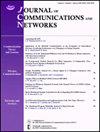Efficient detectors for uplink massive MIMO systems
IF 3.2
3区 计算机科学
Q2 COMPUTER SCIENCE, INFORMATION SYSTEMS
引用次数: 0
Abstract
Massive multiple-input multiple-output (MIMO) is one of the essential technologies in beyond fifth generation (B5G) communication systems due to its impact in attaining high power efficiency and spectrum efficiency. The design of low-complexity detectors for massive MIMO continues to attract significant research and industry attention due to the critical need to find the right balance between performance and computational complexity, especially with a large number of antennas at both the transmitting and receiving sides. It has been noticed in several recent studies that appropriate initialization of iterative data detection techniques plays a crucial role in both the performance and the computational complexity. In this article, we propose three efficient initialization methods that achieve a favorable balance between performance and complexity. Instead of using the conventional diagonal matrix, we employ the scaled identity matrix, the stair matrix, and the band matrix with the first iteration of the Newton method to initialize the accelerated overrelaxation (AOR), the successive overrelaxation (SOR), the Gauss-Seidel (GS), the Jacobi (JA), and the Richardson (RI) based detectors. The scaling factor depends on the minimum and maximum eigenvalues of the equalization matrix. The proposed detectors are tested with different massive MIMO configurations, different modulation schemes (QPSK, 16QAM and 64QAM), and perfect and imperfect channel state information (CSI). Using simulations, we show that the proposed detectors achieve a significant performance gain compared to the minimum mean-squared error (MMSE) based detector, the conventional linear massive MIMO detectors, and other existing detectors, at a remarkable complexity reduction.上行链路大规模多输入多输出系统的高效探测器
大规模多输入多输出(MIMO)是超越第五代(B5G)通信系统的基本技术之一,因为它对实现高功率效率和频谱效率具有重要影响。由于亟需在性能和计算复杂度之间找到合适的平衡点,特别是在发射端和接收端都有大量天线的情况下,为大规模多输入多输出设计低复杂度探测器的工作继续吸引着研究人员和业界的极大关注。最近的一些研究注意到,迭代数据检测技术的适当初始化对性能和计算复杂度都起着至关重要的作用。在本文中,我们提出了三种高效的初始化方法,在性能和复杂度之间取得了良好的平衡。我们没有使用传统的对角矩阵,而是采用了缩放标识矩阵、阶梯矩阵和带状矩阵与牛顿法的第一次迭代,来初始化基于加速过度松弛(AOR)、连续过度松弛(SOR)、高斯-赛德尔(GS)、雅可比(JA)和理查森(RI)的检测器。缩放因子取决于均衡矩阵的最小和最大特征值。我们使用不同的大规模多输入多输出(MIMO)配置、不同的调制方案(QPSK、16QAM 和 64QAM)以及完美和不完美的信道状态信息(CSI)对所提出的检测器进行了测试。通过仿真,我们发现,与基于最小均方误差 (MMSE) 的检测器、传统线性大规模 MIMO 检测器和其他现有检测器相比,所提出的检测器在显著降低复杂性的同时,实现了显著的性能提升。
本文章由计算机程序翻译,如有差异,请以英文原文为准。
求助全文
约1分钟内获得全文
求助全文
来源期刊
CiteScore
6.60
自引率
5.60%
发文量
66
审稿时长
14.4 months
期刊介绍:
The JOURNAL OF COMMUNICATIONS AND NETWORKS is published six times per year, and is committed to publishing high-quality papers that advance the state-of-the-art and practical applications of communications and information networks. Theoretical research contributions presenting new techniques, concepts, or analyses, applied contributions reporting on experiences and experiments, and tutorial expositions of permanent reference value are welcome. The subjects covered by this journal include all topics in communication theory and techniques, communication systems, and information networks. COMMUNICATION THEORY AND SYSTEMS WIRELESS COMMUNICATIONS NETWORKS AND SERVICES.

 求助内容:
求助内容: 应助结果提醒方式:
应助结果提醒方式:


